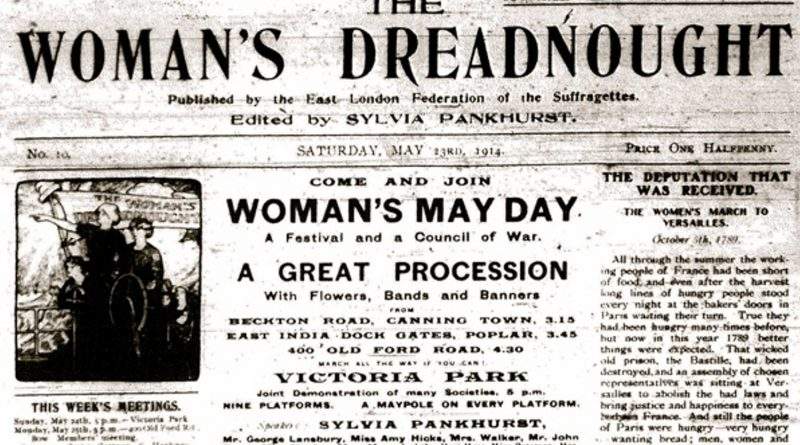Written from life – Sylvia Pankhurst and the Workers’ Dreadnought newspaper
Few know that during her time in Bow, Sylvia Pankhurst’s revolutionary actions included running the Worker’s Dreadnought, her own socialist newspaper focusing on working women and the fight for suffrage.
You’d be hard-pressed to find things Sylvia Pankhurst didn’t do during her time in Bow. When she wasn’t spearheading the East London suffragettes, running a toy factory, organising a people’s army, and opening cut-price restaurants, she edited a newspaper for working women – Workers’ Dreadnought.
Running from 1914 to 1924, Workers’ Dreadnought gave voice to the disenfranchised and a platform for the rising tide of women’s suffrage. Focusing its regional coverage on Bow, Poplar, and Hackney, the paper connected working people with kindred spirits at home and abroad, defying the odds for over a decade.
The Woman’s Dreadnought
To begin with, Workers’ Dreadnought wasn’t Workers’ Dreadnought at all. It was The Woman’s Dreadnought. Zelie Emerson, a member of the East London Federation of Suffragettes, suggested the group launch a socialist newspaper with a focus on working women.
Members opted to call the new publication The Woman’s Dreadnought, a decision Pankhurst deferred to, but in hindsight she wished it had been called The Workers’ Mate. She said: ‘”Mate” was a favourite term of address with our people in the East End, and to my mind a most genial and sympathetic one.’
The slightly more forthright Woman’s Dreadnought was launched on 8 March, 1914. Its chief duty would be ‘to deal with the franchise question from the working-woman’s point of view, and to report the activities of the votes for women movement in East London. Its head office would be 321 Roman Road, and its weekly circulation 20,000.
This special advance edition, distributed from the steps of Trafalgar Square, bore a slogan that would appear in every issue for years to follow: ‘Bravely and willingly we bear our share of the World’s burdens. Why, then, deny us the right to Vote, which would dignify our labour and increase our Power of Service.’
Bravely and willingly we bear our share of the World’s burdens. Why, then, deny us the right to Vote, which would dignify our labour and increase our Power of Service.
dreadnought slogan
The issue was packed with meeting times and news on women’s rights and socialism at home and abroad. East London’s suffrage movement had a voice, a means by which to inform the masses and organise their energies.
Evolution to workers’ paper
Sylvia Pankhurst’s vision for The Dreadnought was not a traditional one. At a time when papers were notoriously dry and stiff in their coverage, academic to the nth degree, she wanted something representative of the lower classes:
‘I wanted the paper to be as far as possible written from life; no dry arguments, but a vivid presentment of things as they are, arguing always from the particular, with all its human features, to the general principle.’
I wanted the paper to be as far as possible written from life; no dry arguments, but a vivid presentment of things as they are, arguing always from the particular, with all its human features, to the general principle.
sylvia pankhurst
Reading through early issues of The Dreadnought, which are available to view at the Tower Hamlets Archives, that vividity shines through. From news pieces to satire, there is a lyricism to the language reflective of its anger and sharpness of purpose.
It was a paper in the thick of East London life. Each issue included district bulletins from Bow, Stepney, and Hackney, amongst others, complete with weekly sales in each area and the women who made them. Bow consistently came out on top, part of a national readership in numbering in the thousands.
The Dreadnought was by and for the suffragette movement. Adverts for the East London Toy Factory, an all-women enterprise backed by Pankhurst, were frequent. (‘Make Christmas orders early to avoid disappointment.’) Photography was often provided by Norah Smyth, who also stepped in as editor when Pankhurst was in prison.
Contributors were drawn from across the globe. American poet Claude McKay wrote for The Dreadnought and recalled distinctly when he first met Pankhurst: ‘Her eyes were fiery, even a little fanatic, with a glint of shrewdness.’
As Pankhurst’s interests expanded from women to class rights, so too did the paper’s, which was renamed Workers’ Dreadnought in July 1917. In the paper’s later years, a hammer and sickle sat at the centre of its masthead.
Final issue of the Worker’s Dreadnought
Running the paper was always an uphill struggle. Anti-capitalist newspapers have never been advertisers’ first choice. From the start Workers’ Dreadnought struggled to fill its ad space. It lasted as long as it did likely owed more to the resolve of the editorial team than to revenue.
Shortly after clocking ten years in print, Workers’ Dreadnought folded in 1924. In 1928, women in the UK were granted the vote on the same terms as men. The paper never had the pleasure of reporting on the realisation of its dream, but it helped make it possible. If a soapbox could be a newspaper, it would look a lot like The Dreadnought.
If you liked this, you may like to read about Sylvia Pankhurst’s life in Bow.


